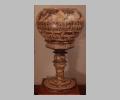| Collection: | Paris, Musée du Louvre |
| Summary: | Shoulder: Side A, Herakles and Kyknos; Side B, Perseus beheading Medusa |
| Ware: | Attic Black Figure |
| Painter: | Name vase of the Gorgon Painter |
| Context: | From Etruria |
| Date: | ca. 590 BC |
| Dimensions: | H. 0.93 m |
| Primary Citation: | |
| Shape: | Dinos and stand |
| Beazley Number: | 300055 |
| Region: | Etruria |
| Period: | Archaic |
Decoration Description:
In the lower panels and on the base, processions of animals are interspersed with chains of lotus and palmette.
On the shoulder two different mythical scenes are depicted with no interruption between. On side A, Herakles and Kyknos have disembarked from their chariots and are fighting hand to hand with their lances. The two bearded charioteers, wearing long chitons, hats, and shields on their backs, watch the combat. One of these figures must be Iolaos, the other Kyknos's half-brother Phobos, although it is difficult to tell which is which. Each warrior is armed with helmet, cuirass and shield. The shield device on the right is a steer's head. Since Herakles has not yet gained his lionskin, distinguishing these two figures from each other is not possible either.
On side B, Perseus has beheaded Medusa. As she falls, her two sisters run to the right after Perseus. Hero and gorgons all wear similar winged shoes and short chitons. Perseus also wears a hat and carries his sword in its scabbard at his left side. Medusa's head is nowhere to be seen. Behind her to the left stand Athena and Hermes, Athena in a long dress, mantle and headband, Hermes dressed similarly to Perseus, holding his staff in his hand.
Sources Used:
